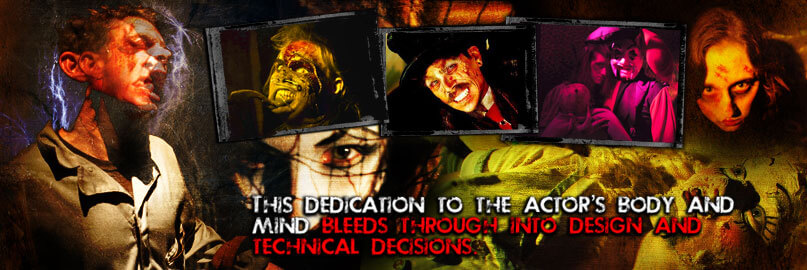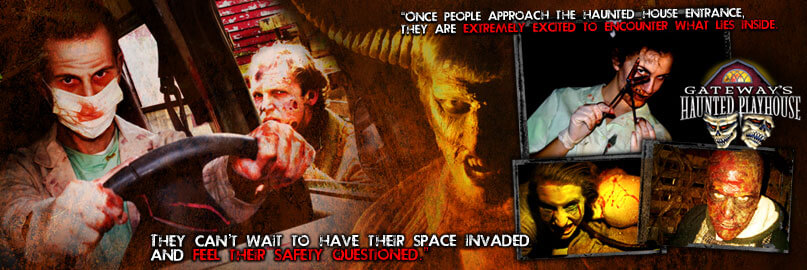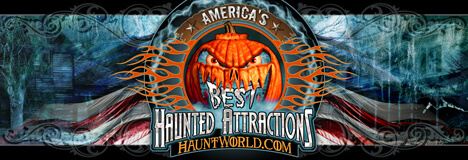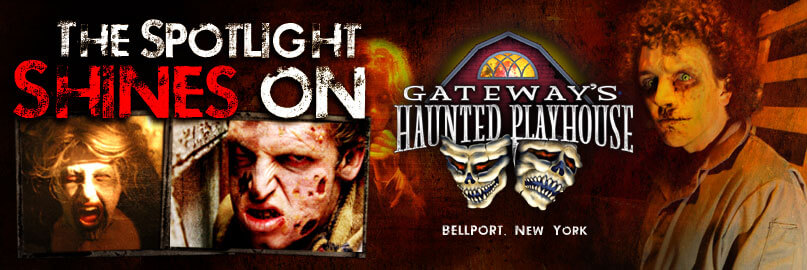|
Long Island New York is the home of one of the scariest haunted houses in America called Gateway's Haunted Playhouse. New York has many incredible haunted houses and Hauntworld rates and reviews the best haunted attractions in America. Hauntworld can help you find hundreds of haunted houses in New York and Long Island.
Gateway’s Haunted Playhouse is the rare occasion that brings the words “haunted house” and “professional theatre” together in the same sentence. And, although these thoughts appear to be worlds apart, the Gateway Playhouse proves that the two subjects not only go — but also can grow — together …And GROW they have!
The Gateway Playhouse is located in Bellport, N.Y.—a coastal village that lies on Long Island’s south shore, 60 miles east of Manhattan. The Gateway, now a non-profit organization, was first established in 1950 and remains the region’s oldest professional theatre. Since the early days of summer stock shows, limited staff and shoestring budgets, the organization currently employs over 200 theatre professionals who cast, design, build, stage and perform in nearly ten Broadway quality productions each year. Gateway’s Haunted Playhouse first launched in 2009, during the middle of America’s “great recession.” Paul Allan, the theatre’s managing producer, recalls that this haunted house move had been discussed for several years prior, as a way to compliment the theatre’s main business. “Our staff originated the idea of doing a haunted house. We would talk about it at the end of production meetings for our summer shows — or often times after work over a few drinks,” Allan said. “Our summer season of musicals ends in September and many of our creative staff and technicians worked at haunts in New York and across the country during our down time. Gateway’s Haunted Playhouse was born because they were enthusiastic about creating our own haunt.”
For Allan, a haunted house has all the elements of a great theatrical performance and also allows the theatre’s artists to exercise every fiber of their creative muscle. Compared to a theatrical production that has a predetermined script and setting, the haunt provides a blank slate that is ripe for creativity. One such creator is haunt director Michael Baker, a longtime aficionado of haunted attractions. Every year, Baker, Allan and the theatre’s staff set a new theme and concept for each version of Gateway’s Haunted Playhouse. These stories are built on historical facts and are often spun from the theatre’s rich history. One such story involved the horrible creations of a demented prop maker from the early days of the theatre, while another showed the lasting effects of a vengeful caretaker. These tales come to life when placed against the backdrop of the Gateway property — a mix of different architectures that create a macabre visual appearance when properly lit. Some buildings remain from the original settlement, now centuries old, while others were constructed by the prominent Mott family after the Civil War. It is widely believed that members of the Mott family still haunt the playhouse and its surrounding buildings.
 Recently, the theme has been borrowed from strange occurrences outside the theatre. Long Island is home to many government laboratories — each with their own unique lore — which provided the groundwork for the creation of a government controlled airborne virus brought havoc to the surrounding community of Bellport. As a result, 2012’s haunt was christened “Hellport” and a dystopian version of the tranquil village was reproduced inside the walkthrough attraction.
Once a theme has been decided, Baker begins conversations with wig and makeup designer Trent Pcenicni, who sketches specific characters that deepen the storyline. Each room in the haunt will be themed around the lives of these individuals. Baker and Pcenicni take great care to include a wide assortment of characters and types of scares so that people of all ages and backgrounds — from those who plunge head first into the haunt, to those who cower at the tail end of each group — are affected by what’s inside. This mixture of characters and effects is designed to assault all bodily senses for the scariest haunted house experience possible. In some rooms, pungent odors of rotting flesh and raw sewage clog the air. In others, patrons wade their way through a sinking floor and feel their way through a dark room, blockaded by bodybags suspended from the ceiling like hanging meat in a haunted butcher shop. Around another corner, patrons cower in fear as they come face-to-face with a shower of sparks created by a burly, chainsaw wielding psycho who wildly slices through an electrified fence. While these haunting characters provide ample scares for patrons, their sensorial assault is also used to setup a deeper, subtle, more lasting fright: the “psychological” scare. This haunt technique utilizes the character’s inner emotional state — not just what the character is doing — to achieve its outcome.
Pcenicni describes a “naked man” character in order to illustrate how a “psychological” scare can be effective when placed against other types of terror. During one haunt sequence, patrons had their senses jarred by a sequence of moving floors, a loud “startle scare” in an electrocution chamber, and an eerie environment filled with televisions emitting static. They then discovered a character that appeared to be nude, lying motionless and speechless on the floor of the following room. Despite not having to speak or move, the actor accomplished his scare, because he remained true to his story. Moreover, patrons continued to rave over the existence of this ‘naked man’ long after exiting the haunted house, even as they walked to their cars.
This type of committed, live actor gives Gateway’s Haunted Playhouse its unique intimacy. Quality acting has long been synonymous with the Gateway name, as actors such as Robert Duvall, David Carradine and Gene Hackman have trod the boards on its stage. The theatre is also home to the Gateway Acting School, which trains nearly 300 young actors annually. Baker, a Gateway Acting School instructor and member of Actors’ Equity Association, teaches and rehearses each company of haunt actors. Although many are trained stage, film and television actors, the entire cast undergoes a general audition to assess how each could be suitable in particular roles and scenes. During the audition, actors assemble into groups and are first encouraged to utilize their senses of smell and taste as they act out facing cold, wet or arid conditions. Specific rehearsals are devoted to voice, which helps each company member produce a catalog of sounds — from loud screams and dizzying cacophonies, to low groans and slight whimpers. As the improvisations become more specific, all actors explore three different character types: victim, aggressor and helper. Baker believes that this process lays a foundation for any scene that would be included in the haunt. “We rehearse over and over because it’s important that the actors are comfortable in their circumstances. These sessions give them the tools necessary to stay in character,” Baker said. “There’s no ‘right or wrong’ in how to act. It’s about commitment to the situation. Even transitions in our haunt are still scenes and require the same level of commitment, in character. After each scare, our actors are trained to maintain their focus as they reset and prepare for the next group of haunted house victims.” This dedication to the actor’s body and mind bleeds through into design and technical decisions. Although full, over-the-head masks are often used for intimidation, Gateway’s Haunted Playhouse prefers not to depend on them solely, because they constrict the actors’ emotive abilities. Instead, costumes and makeup applications are relied on to make a distinct, visual look that is specific to each haunt character.

Given that haunted house actors are seen up close, these distinct looks must be intricately recreated. Pcenicni and six other makeup artists begin applications three hours before the haunt begins. To speed things along, the makeup team uses two dozen airbrushes filled with cosmetic grade paint. After the night is over, it takes another hour and a half to remove prosthetics and other effects. Once the first group of patrons enters the haunt, Baker monitors and communicates with each actor to maintain the high quality of each performance. Actors carry character description cards that prove extremely useful when a standby or replacement actor is needed. Baker encourages his haunted house cast to experiment, keeping in mind that timeliness and consistency are crucial for the smooth run of each haunt. “We have the freedom to play in rehearsals, but we also have to reset in a matter of seconds as new patrons come through the haunt,” Baker said. “It’s important that the actors not spend a lot of time with each group, because we need to keep the flow moving.” The flow becomes more and more critical as attendance multiplies each year. Although Gateway’s Haunted Playhouse attracted only 2,500 people during its 2-week debut season, attendance TRIPLED the following year and DOUBLED the next! The haunt schedule has expanded from two to six weeks to meet this demand and now continues into November, as well. This huge increase in attendance is a direct tribute to the quality production at Gateway’s Haunted Playhouse. These figures have given Gateway’s Haunted Playhouse the resources to extend its construction period from a number of days to two full months, giving patrons a more satisfying, detailed experience. Each year, the haunt must be quickly built and tore down, to accommodate the theatre’s winter production schedule. The acting company has also grown thanks to this increased attendance. What began with only a few professional actors and several volunteers from the Gateway Acting School and the theatre’s technical staff has grown to include 40 professional actors and another 40-50 volunteers. During the Halloween season, nearly 120 people are included on the payroll, taking technical, sales, security, custodial, parking and concessions staff into account.
Each year, the walkthrough path moves to include new areas on the property and concepts continue to evolve as the organization gains more and more experience in the haunted house genre. The original end sequence required patrons to turn and witness an onstage scene — like in a theatrical production. Now, patrons are encouraged to discover and connect stories and events at their own pace, instead of watching an act unfold in front of them. This relationship is now established before the haunt actually begins. “Once people approach the haunted house entrance, they are extremely excited to encounter what lies inside. In this state of suspense, asking them to read a written story or watch a preview movie — which we have done in the past — has proven to be counterproductive,” Allan reasons. “We now let the story unfold inside, with them being a part of it. They can’t wait to have their space invaded and feel their safety questioned.”

This illusion of danger, amplified by a disorienting haunt environment, can spark a distinct, different emotional response from each patron. Because these reactions are sometimes difficult to predict, Gateway’s Haunted Playhouse takes great measures to keep all parties free from actual harm. A dedicated security team has always been in place for each haunt and is now headed by a retired officer and training specialist from the Suffolk County Police Department. This force has the capability to anticipate and address any situation within moments, thanks to dozens of two-way radios that are operated by actors, technicians and staff. Although each instance of growth has led to valued change, the theatre proudly maintains the haunt’s intimacy by giving each effect a human touch, even in a digitized age. Pcenicni has personally made dozens of hands, feet and severed heads, in addition to his other duties. And, although the haunt uses a limited amount of automation, all effects are controlled by a computer program called VenueMagic, which grants the theatre’s technicians precise, moment-to-moment, control over any effect.
This dedication to even the smallest of details has not gone unrecognized. Gateway’s Haunted Playhouse has received favorable reviews from the New York Times, was named on USA Today’s “Top Ten Haunted Houses in New York” and was voted “Best Haunted House on Long Island” for two years in a row by News12 — the area’s leading television news outlet. Allan hopes that this wide appeal will familiarize more people with the theatre’s high level of artistry and, in turn, bring a new demographic of patron to the playhouse’s other events throughout the year. With regional and statewide accolades under their belt, as well as thousands of patrons anticipating the newest installment, how will Gateway’s Haunted Playhouse continue to grow?
Baker sums it up best: “We always ask, ‘what haven’t we done. Where else can we go?’”
|



















